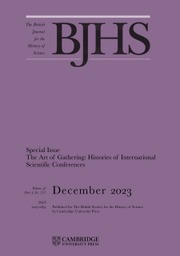‘The past is a foreign country: they do things differently there’, wrote L.P. Hartley in his 1953 The Go-Between. Stranges’s hefty volume, with its cover bearing the faces of four stern male German chemists and its account of the attraction of petroleum, testifies to that. The endeavour to produce petroleum from coal cost very large amounts of money, consuming the careers of many people and the lives of even more. It was crucial to Nazi Germany’s ability to fight a six-year war and was internationally emulated, but at the beginning of the twenty-first century the dream has faded. The environment, the author assures us, was not a theme in the writings of the people and corporations he has looked into. Moreover, many of the huge companies this book explores, including IG Farben, Standard Oil and ICI, have gone.
This, then, is an analysis of a bygone age. By the end of the First World War, it was clear to many that the era of coal would end, and that the era of oil was just beginning. Automobiles and aeroplanes were petroleum-native technologies, and both ships and locomotives were transferring to petroleum fuels. Meanwhile, millions of people were employed directly in extracting coal and millions more were dependent on their declining spending. Germany, a coal-rich country, had little oil, but two impending superpowers, the United States and the Soviet Union, were oil-rich. The solution that appealed to chemists, particularly in Germany, was to transform coal into oil.
Stranges has been writing about the effort to synthesize oil for more than forty years. In a series of classic papers, he preserved for future historians an international story. This book is based on modified and updated versions of those separate papers, integrated for the first time. The key resource on which he has drawn is the huge archive of German material trawled by British and American investigators in the immediate aftermath of the Second World War and now available at Texas A & M University, where he works. This volume itself is a chronicle of huge value.
Following an overview first chapter, two subsequent chapters deal with the dominant German effort. The first takes off from the perspective of lead scientists, such as Bergius. The second deals with the corporate level. Much of this testifies to long-term planning and technological prowess that led to the building of twelve coal hydrogenation plants and nine Fischer–Tropsch synthesis plants. The former added hydrogen to coal under high pressure and temperature; the latter broke down coal to carbon monoxide and hydrogen and, from these ingredients, catalytically synthesized oil. Engineering and chemical data on the processes and the complex equipment used have been carefully excavated and presented. Important accounting and production information is also provided. With gruesome detail, Stranges tells us about the 25,000 to 30,000 deaths among workers at Auschwitz, many of them working on the failed attempt to build a coal oil plant there. We learn of the payments made on account of their work by IG Farben to the SS. The following chapters deal individually with the coal oil work in interwar Britain, wartime Japan, Canada and then the United States. These are modified forms of previous articles, but there is also a final chapter dealing with Italian and French interwar activities and ‘Post–World War II synthetic fuel development and the emergence of environmental concerns’.
The final chapter includes treatment of the South African Sasoil programme and a few pages treating acid rain and global warming, pointing to a recognition of their importance but hardly addressing these complex political, commercial and technological issues. Perhaps surprisingly, the work of Naomi Oreskes on corporate responses to global warming is not cited. The dependence of other chapters on earlier articles leads to odd arrangements. We find the treatment of the important British firm Low Temperature Carbonisation Ltd hidden away in the chapter on the American effort. There are also many more archives with relevant materials than even Stranges has explored. Thus, in Britain, The National Archives hold the papers of the subsequently nationalized coal company Powell Duffryn, which during the 1930s looked in detail at the possible application of coal liquefaction.
It would be regrettable if this book, comprehensive as it is, were to be seen as the massive bookend to a hitherto partial literature. It would be a mark of this volume’s true worth if it sparks new questions. Thus it tells readers about the links between the Canadian petroleum-cracking developments and their coal oil work in the 1940s. This book provokes such questions as: did the huge efforts made by the oil industry, led by Standard Oil, to develop the fluidized-bed catalytic cracker draw on coal oil research? There is an opportunity to understand better the links between the intensity of political anxieties that surrounded both the decline of the coal industry and the shortage of domestic oil and the huge efforts across countries that Stranges describes. In his thirty-seven-page treatment of British efforts, there are fewer than five pages set off in the section on ‘Politics and economics’. Low-temperature carbonization makes fleeting appearances throughout the book, particularly in the treatment of Japan, but there is no systematic reflection on its links to coal liquefaction. The links in Britain between ICI and Low Temperature Carbonisation Ltd, which supplied smokeless fuel to homes and government offices to fight ‘the smoke menace’, as well as creosote to ICI, are overlooked. In an era of cultural history, there is space to build on this work.



